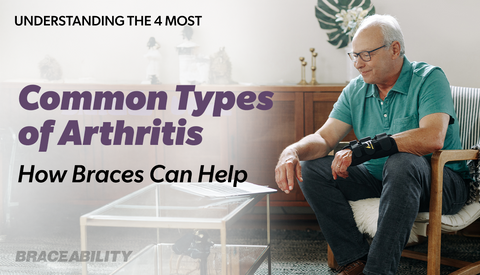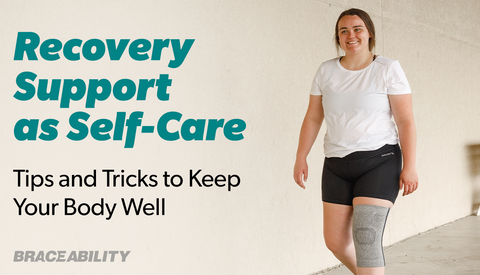Commitment to Comfort Spotlight: De Quervain's Tenosynovitis
Commitment to Comfort: Tackling De Quervain’s Tenosynovitis with Support That Heals
Whether you're a new parent lifting a baby, a construction worker handling tools, or a tech-savvy professional scrolling all day, your hands and wrists are constantly in motion. But when those small, repetitive movements trigger pain near the base of your thumb, you might be facing a common yet frustrating condition: De Quervain’s Tenosynovitis.
This month in our Commitment to Comfort series, we’re shining a light on this painful tendon condition, and more importantly, how to treat it with targeted, effective support. If you’ve been experiencing pain on the thumb side of your wrist, you’re not alone, and you’re not without options.
What Is De Quervain’s Tenosynovitis?
De Quervain’s Tenosynovitis is an inflammation of the tendon sheath (the protective lining around your tendons) located at the base of the thumb. Specifically, it affects the abductor pollicis longus and extensor pollicis brevis tendons: two key tendons that control thumb movement. When inflamed, these tendons can’t glide smoothly within their sheath, leading to pain, stiffness, and swelling.

Common Symptoms Include:
-
Pain near the base of the thumb or on the side of the wrist
-
Swelling or tenderness near the thumb joint
-
A catching or “sticking” sensation when moving the thumb
-
Difficulty gripping, pinching, or lifting objects
-
Worsening pain with repetitive hand or thumb movements
This condition often develops gradually, but in some cases, it can come on suddenly, particularly after overuse or trauma. De Quervain’s is commonly associated with new parenthood (sometimes nicknamed “Mommy Thumb”), occupations involving repetitive wrist/thumb use, and inflammatory conditions like rheumatoid arthritis.
Tenosynovitis vs. Tendonitis: What’s the Difference?
While they sound similar, and share overlapping symptoms, tenosynovitis and tendonitis refer to inflammation in different parts of the tendon system.
-
Tendonitis is inflammation of the tendon itself
-
Tenosynovitis is inflammation of the protective sheath surrounding the tendon
Both can cause pain, reduced mobility, and functional limitations, but tenosynovitis tends to produce more swelling and friction-like symptoms. Thankfully, many treatment strategies, including bracing, support both conditions effectively.
How to Treat De Quervain’s Tenosynovitis
De Quervain’s can significantly impact your daily life, but with the right approach, healing is within reach. The first and most important step is immobilization. Reducing movement in the affected tendons allows inflammation to subside and tissues to heal.
One of the most trusted tools for that immobilization is our Wrist and Thumb Spica Splint, a thoughtfully designed solution made specifically to help you reclaim comfort and mobility.

The Brace You Can Count On: Wrist & Thumb Spica Splint
Our Wrist and Thumb Spica Splint is your go-to brace for De Quervain’s Tenosynovitis, crafted to provide structured support exactly where it’s needed, without sacrificing comfort or flexibility.
Why This Brace Stands Out:
Targeted Immobilization:
An ergonomic aluminum stay offers firm yet comfortable support that contours to your wrist and thumb, stabilizing both the MP (metacarpophalangeal) and CMC (carpometacarpal) joints.
Removable Splints for Tailored Support:
Every healing journey is unique. That’s why this spica splint features removable wrist and thumb stays, allowing you to customize the level of support based on your stage of recovery.
Day & Night Comfort:
Lightweight, breathable fabric makes this brace ideal for all-day wear. You can sleep, work, or go about your routine without irritation or overheating.
Encourages Natural Healing:
By gently guiding your wrist and thumb into a healing position, this brace allows inflammation to reduce while preventing further strain, supporting a natural and lasting recovery.
Adjustable Compression:
Secure fastener straps ensure snug compression around the wrist and thumb, helping reduce swelling and pain while also keeping the brace securely in place.
Versatile Recovery Tool
While specially designed for De Quervain’s, this brace also supports recovery from:
-
Thumb or wrist tendonitis
-
Sprains and strains
-
Rheumatoid arthritis
-
Carpal tunnel syndrome
-
Rhizarthrosis (thumb arthritis)
-
Post-cast recovery after fractures
This multi-condition functionality makes it a smart investment for anyone seeking reliable, medical-grade wrist and thumb support.
Three More Tips for Recovery: RICE & Beyond
In addition to bracing, a few simple techniques can help manage symptoms and accelerate recovery:
1. RICE Method
-
Rest: Avoid activities that trigger pain or require gripping or twisting motions.
-
Ice: Apply a cold pack to the affected area for 15–20 minutes at a time, several times a day.
-
Compression: Your spica splint provides built-in compression, but you can also use a compression wrap or sleeve as needed.
-
Elevation: When possible, elevate your hand and wrist to help reduce swelling.
2. Stretching & Physical Therapy
Once pain decreases, your healthcare provider may recommend gentle stretches or strengthening exercises. These help restore mobility and prevent future flare-ups.
3. Ergonomic Adjustments
Look at your work and home setup. If you’re using your hands repetitively (texting, typing, lifting), explore ergonomic tools or break up tasks to give your tendons a break.
Your Solution to De Quervain's: Wrist & Thumb Spica Splint
Early and consistent treatment, especially with a high-quality brace like the Wrist & Thumb Spica Splint, can prevent long-term issues and get you back to doing what you love.
Many people find that within a few weeks of wearing the brace and following basic care guidelines, symptoms begin to fade. And with continued use and care, De Quervain’s can be a temporary inconvenience, not a lifelong limitation.
The Bottom Line: Comfort That Moves with You
Whether you're swaddling a baby, gardening, or just trying to send a text without wincing, De Quervain’s Tenosynovitis can be a frustrating barrier. But with the right support system, including a proven, ergonomic brace, you can take meaningful steps toward healing.
BraceAbility’s Wrist and Thumb Spica Splint isn’t just another brace. It’s a recovery partner, a pain reliever, and a comfort enhancer, crafted for people like you who are ready to get back to life, pain-free.











